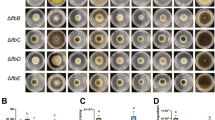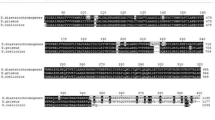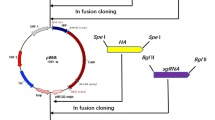Abstract
In Bacillus, the spore formation process is associated with the synthesis and release of secondary metabolites. A large number of studies have been conducted to systematically elucidate the pathways and mechanisms of spore formation. However, there are no studies have explored the relationship between secondary metabolites and spores. In this study, we investigated the relationship between its secondary metabolite bacillomycin D (BD) and spores using the simpler dipicolonic acid fluorimetry assay for spore counting in Bacillus amyloliquefaciens fmbJ. Our results showed that BD could promote the spore formation of B. amyloliquefaciens fmbJ and had a synergistic effect with certain concentrations of Mn2+. When 15.6 mg/L of BD and 1 mM of Mn2+ were added, the number of fmbJ spores increased from 1.42 × 108 CFU/mL to 2.02 × 108 CFU/mL after 36 h of incubation. The expressions of spore formation (kinA, kinB, kinC, kinD, kinE and spo0A) and Mn-related genes (mntA, mntH, mneS, mneP) were studied by RT-PCR. The results indicated that BD and Mn2+ promoted the spore formation of fmbJ by stimulating the transcription of kinB, kinD and increasing the influence of spo0F-spo0A phosphorylation transmission. This study provided a new idea to improve the spore production of B. amyloliquefaciens and laid the foundation for its industrial production.


Similar content being viewed by others
Availability of data and material
The data used to support the findings of this study are available from the corresponding author upon request.
References
Setlow P (2006) Spores of Bacillus subtilis: their resistance to and killing by radiation, heat and chemicals. J Appl Microbiol 101(3):514–525. https://doi.org/10.1111/j.1365-2672.2005.02736.x
Mingmongkolchai S, Panbangred W (2019) Display of Escherichia coli phytase on the surface of Bacillus subtilis spore using cotG as an anchor protein. Appl Biochem Biotechnol 187(3):838–855. https://doi.org/10.1007/s12010-018-2855-7
Dai X, Liu M, Pan K, Yang J (2018) Surface display of OmpC of Salmonella serovar pullorum on Bacillus subtilis spores. PLoS ONE 13(1):e0191627. https://doi.org/10.1371/journal.pone.0191627
Aps L, Tavares MB, Rozenfeld JHK, Lamy MT, Ferreira LCS, Diniz MO (2016) Bacterial spores as particulate carriers for gene gun delivery of plasmid DNA. J Biotechnol 228:58–66. https://doi.org/10.1016/j.jbiotec.2016.04.027
Yang M, Zhu G, Korz G, Setlow XS, Lia J (2020) Engineering Bacillus subtilis as a versatile and stable platform for production of nanobodies. Appl Environ Microbiol 86:02938–2919. https://doi.org/10.1128/AEM
Hinc K, Ghandili S, Karbalaee G, Shali A, Noghabi KA, Ricca E, Ahmadian G (2010) Efficient binding of nickel ions to recombinant Bacillus subtilis spores. Res Microbiol 161(9):757–764. https://doi.org/10.1016/j.resmic.2010.07.008
Rostami A, Hinc K, Goshadrou F, Shali A, Bayat M, Hassanzadeh M, Amanlou M, Eslahi N, Ahmadian G (2017) Display of B. pumilus chitinase on the surface of B. subtilis spore as a potential biopesticide. Pestic Biochem Physiol 140:17–23. https://doi.org/10.1016/j.pestbp.2017.05.008
Lin P, Yuan H, Du J, Liu K, Liu H, Wang T (2020) Progress in research and application development of surface display technology using Bacillus subtilis spores. Appl Microbiol Biotechnol 104(6):2319–2331. https://doi.org/10.1007/s00253-020-10348-x
Hutchison EA, Miller DA, Angert ER (2014) Sporulation in bacteria: beyond the standard model. Microbiol Spectr. https://doi.org/10.1128/microbiolspec.TBS-0013-2012
Beauregard PB, Chai Y, Vlamakis H, Losick R, Kolter R (2013) Bacillus subtilis biofilm induction by plant polysaccharides. PNAS 110(17):621–1630. https://doi.org/10.1073/pnas.1218984110
Qian S, Lu H, Meng P, Zhang C, Lv F, Bie X, Lu Z (2015) Effect of inulin on efficient production and regulatory biosynthesis of bacillomycin D in Bacillus subtilis fmbJ. Bioresource Technol 179:260–267. https://doi.org/10.1016/j.biortech.2014.11.086
López D, Fischbach MA, Chu F, Losick R, Kolter R (2009) Structurally diverse natural products that cause potassium leakage trigger multicellularity in Bacillus subtilis. PNAS 106(1):280–285. https://doi.org/10.1073/pnas.0810940106
Shemesh M, Chai Y (2013) A combination of glycerol and manganese promotes biofilm formation in Bacillus subtilis via histidine kinase kind signaling. Appl Environ Microb 195(12):2747–2754. https://doi.org/10.1128/JB.00028-13
Sharipova MR, Mardanova AM, Rudakova NL, Pudova DS (2021) Bistability and formation of the biofilm matrix as adaptive mechanisms during the stationary phase of Bacillus subtilis. Microbiology 90(1):24–42. https://doi.org/10.1134/S002626172006017X
Su Y-t, Liu C, Long Z, Ren H, Guo X-h (2019) Improved production of spores and bioactive metabolites from Bacillus amyloliquefaciens in solid-state fermentation by a rapid optimization process. Probiotics Antimicro 11:921–930. https://doi.org/10.1007/s12602-018-9474-z
Berikashvili V, Sokhadze K, Kachlishvili E, Elisashvili V, Chikindas ML (2018) Bacillus amyloliquefaciens spore production under solid-state fermentation of lignocellulosic residues. Probiotics Antimicro 10(4):755–761. https://doi.org/10.1007/s12602-017-9371-x
Zhao X, Han Y, Tan XQ, Wang J, Zhou ZJ (2014) Optimization of antifungal lipopeptide production from Bacillus sp. BH072 by response surface methodology. J Microbiol 52(4):324–323
Stein T (2005) Bacillus subtilis antibiotics: structures, syntheses and specific functions. Mol Microbiol 56(4):845–857. https://doi.org/10.1111/j.1365-2958.2005.04587.x
Zhou M, Liu F, Yang X, Jin J, Dong X, Zeng K-W, Liu D, Zhang Y, Ma M, Yang D (2018) Bacillibactin and bacillomycin analogues with cytotoxicities against human cancer cell Lines from marine bacillus sp. PKU-MA00093 and PKU-MA00092. Mar Drugs 16(1):22
Wu T, Chen M, Zhou L, Lu F, Bie X, Lu Z (2020) Bacillomycin D effectively controls growth of Malassezia globosa by disrupting the cell membrane. Appl Microbiol Biotechnol 104(8):3529–3540. https://doi.org/10.1007/s00253-020-10462-w
Sun J, Liu Y, Lin F, Lu Z, Lu Y (2021) CodY, ComA, DegU and Spo0A controlling lipopeptides biosynthesis in Bacillus amyloliquefaciens fmbJ. J Appl Microbiol 131(3):1289–1304. https://doi.org/10.1111/jam.15007
Caulier S, Nannan C, Gillis A, Licciardi F, Bragard C, Mahillon J (2019) Overview of the antimicrobial compounds produced by members of the Bacillus subtilis group. Front Microbiol 10:302. https://doi.org/10.3389/fmicb.2019.00302
Hajare SN, Subramanian M, Gautam S, Sharma A (2013) Induction of apoptosis in human cancer cells by a Bacillus lipopeptide bacillomycin D. Biochimie 95(9):1722–1731. https://doi.org/10.1016/j.biochi.2013.05.015
Tabbene O, Azaiez S, Di Grazia A, Karkouch I, Ben Slimene I, Elkahoui S, Alfeddy MN, Casciaro B, Luca V, Limam F, Mangoni ML (2016) Bacillomycin D and its combination with amphotericin B: promising antifungal compounds with powerful antibiofilm activity and wound-healing potency. J Appl Microbiol 120(2):289–300. https://doi.org/10.1111/jam.13030
Zhao H, Shao D, Jiang C, Shi J, Li Q, Huang Q, Rajoka MSR, Yang H, Jin M (2017) Biological activity of lipopeptides from Bacillus. Appl Microbiol Biotechnol 101(15):5951–5960. https://doi.org/10.1007/s00253-017-8396-0
Sun J, Li W, Liu Y, Lin F, Huang Z, Lu F, Bie X, Lu Z (2018) Growth inhibition of Fusarium graminearum and reduction of deoxynivalenol production in wheat grain by bacillomycin D. J Stored Prod Res 75:21–28. https://doi.org/10.1016/j.jspr.2017.11.002
Gu Q, Yang Y, Yuan Q, Shi G, Wu L, Lou Z, Huo R, Wu H, Borriss R, Gao X, Elliot MA (2017) Bacillomycin D produced by Bacillus amyloliquefaciens is involved in the antagonistic interaction with the plant-pathogenic fungus Fusarium graminearum. Appl Environ Microbiol 83(19):e01075-e1017. https://doi.org/10.1128/AEM.01075-17
Moyne A-L, Cleveland TE, Tuzun S (2004) Molecular characterization and analysis of the operon encoding the antifungal lipopeptide bacillomycin D. FEMS Microbiol Lett 234(1):43–49. https://doi.org/10.1016/j.femsle.2004.03.011
Qian S, Sun J, Lu H, Lu F, Bie X, Lu Z (2017) L-Glutamine efficiently stimulates biosynthesis of bacillomycin D in Bacillus subtilis fmbJ. Process Biochem 58:224–229. https://doi.org/10.1016/j.procbio.2017.04.026
Gong Q, Zhang C, Lu F, Zhao H, Bie X, Lu Z (2014) Identification of bacillomycin D from Bacillus subtilis fmbJ and its inhibition effects against Aspergillus flavus. Food Control 36(1):8–14. https://doi.org/10.1016/j.foodcont.2013.07.034
López-García B, Pérez-Payá E, Marcos JF (2002) Identification of novel hexapeptides bioactive against phytopathogenic fungi through screening of a synthetic peptide combinatorial library. Appl Environ Microb 68(5):2453–2460. https://doi.org/10.1128/AEM.68.5.2453-2460.2002
Bartholomew JW, Mittwer T (1950) A simplified bacterial spore stain. Stain Tech 25(3):153–156. https://doi.org/10.3109/10520295009110979
Liang XS, Liu C, Long Z, Guo X-H (2018) Rapid and simple detection of endospore counts in probiotic Bacillus cultures using dipicolinic acid (DPA) as a marker. AMB Express 8(1):2–8. https://doi.org/10.1186/s13568-018-0633-0
Ren H, Su Y, Guo X (2018) Rapid optimization of spore production from Bacillus amyloliquefaciens in submerged cultures based on dipicolinic acid fluorimetry assay. AMB Express 8(1):21. https://doi.org/10.1186/s13568-018-0555-x
Jhon D-Y (2018) pH-dependence of RNA extraction for norovirus by trizol method. J Food Saf Food Qual 33(1):71–76
Li H, Lu Y, Pang J, Sun J, Yang F, Wang Z, Liu Y (2019) DNA-scaffold copper nanoclusters integrated into a cerium(III)-triggered Fenton-like reaction for the fluorometric and colorimetric enzymatic determination of glucose. Mikrochim Acta 186(12):2–9. https://doi.org/10.1007/s00604-019-4008-2
Wood J, Osman A, Wade S (2019) An efficient, cost-effective method for determining the growth rate of sulfate-reducing bacteria using spectrophotometry. MethodsX 6:2248–2257. https://doi.org/10.1016/j.mex.2019.09.036
Granger AC, Gaidamakova EK, Matrosova VY, Daly MJ, Setlow P (2011) Effects of Mn and Fe levels on Bacillus subtilis spore resistance and effects of Mn2+, other divalent cations, orthophosphate, and dipicolinic acid on protein resistance to ionizing radiation. Appl Environ Microb 77(1):32–40. https://doi.org/10.1128/AEM.01965-10
Helmann JD (2014) Specificity of metal sensing: iron and manganese homeostasis in Bacillus subtilis. J Biol Chem 289(41):28112–28120. https://doi.org/10.1074/jbc.R114.587071
Chandrangsu P, Rensing C, Helmann JD (2017) Metal homeostasis and resistance in bacteria. Nat Rev Microbiol 15(6):338–350. https://doi.org/10.1038/nrmicro.2017.15
Rao YK, Tsay K-J, Wu W-S, Tzeng Y-M (2007) Medium optimization of carbon and nitrogen sources for the production of spores from Bacillus amyloliquefaciens B128 using response surface methodology. Process Biochem 42(4):535–541. https://doi.org/10.1016/j.procbio.2006.10.007
Tzeng YM, Rao YK, Tsay KJ, Wu WS (2008) Effect of cultivation conditions on spore production from Bacillus amyloliquefaciens B128 and its antagonism to Botrytis elliptica. J Appl Microbiol 104(5):1275–1282. https://doi.org/10.1111/j.1365-2672.2007.03683.x
Min J, Weilan S, Perego M, Hoch JA (2000) Multiple histidine kinases regulate entry into stationary phase and sporulation in Bacillus subtilis. Mol Microbiol 38:535–542. https://doi.org/10.1046/j.1365-2958.2000.02148.x
Xu Z, Mandic-Mulec I, Zhang H, Liu Y, Sun X, Feng H, Xun W, Zhang N, Shen Q, Zhang R (2019) Antibiotic bacillomycin D affects iron acquisition and biofilm formation in Bacillus velezensis through a btr-mediated FeuABC-dependent pathway. Cell Rep 29(5):1192–1202. https://doi.org/10.1016/j.celrep.2019.09.061
Huang X, Shin J-H, Pinochet-Barros A, Su TT, Helmann JD (2017) Bacillus subtilis MntR coordinates the transcriptional regulation of manganese uptake and efflux systems. Mol Microbiol 103(2):253–268. https://doi.org/10.1111/mmi.13554
Wei Y-H, Chu I-M (2002) Mn2+ improves surfactin production by Bacillus subtilis. Biotechnol Lett 24:479–482. https://doi.org/10.1023/A:1014534021276
Inès M, Dhouha G (2015) Lipopeptide surfactants: Production, recovery and pore forming capacity. Peptides 71:100–112. https://doi.org/10.3109/10520295009110979
Sy-Cordero AA, Pearce CJ, Oberlies NH (2012) Revisiting the enniatins: a review of their isolation, biosynthesis, structure determination and biological activities. J Antibiot 65(11):541–549. https://doi.org/10.1038/ja.2012.71
Acknowledgements
This work was financially supported by grants from the Natural Science Foundation of Jiangsu Province-China (BK20200835) and the Priority Academic Program Development of Jiangsu Higher Education Institutions-China (PAPD).
Author information
Authors and Affiliations
Contributions
Jing Sun and Yingjian Lu conceived and designed research. Jin Zhang and Xiaojiao Luo conducted experiments. Jing Sun and Jin Zhang analyzed data and wrote the manuscript. Xinyi Pang and Xiangfei Li revised the manuscript. All authors read and approved the manuscript.
Corresponding authors
Ethics declarations
Conflicts of interest
The authors declare that they have no conflict of interest.
Ethical approval
This article does not contain any studies with humans or animals performed by any of the authors.
Additional information
Publisher's Note
Springer Nature remains neutral with regard to jurisdictional claims in published maps and institutional affiliations.
Supplementary Information
Below is the link to the electronic supplementary material.
Rights and permissions
About this article
Cite this article
Zhang, J., Luo, X., Pang, X. et al. Promoted Spore Formation of Bacillus amyloliquefaciens fmbJ by its Secondary Metabolite Bacillomycin D Coordinated with Mn2+. Indian J Microbiol 62, 531–539 (2022). https://doi.org/10.1007/s12088-022-01026-9
Received:
Accepted:
Published:
Issue Date:
DOI: https://doi.org/10.1007/s12088-022-01026-9




